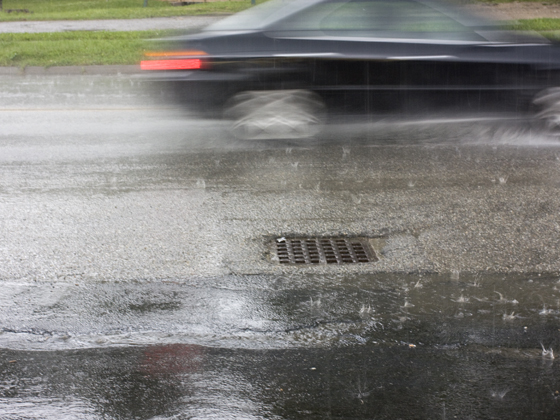Scotch Mist

My favourite story of rain in literature is Hemingway’s Cat in the Rain. It’s a short story, to the point and perfect and yet complex, rich and layered. A young American couple are on holiday, trapped unhappily together in a claustrophobic hotel room. Outside, the rain is languid, dripping from the palm trees and glistening on bronze. Under the couple’s window a cat is crouched under a green table. The cat, and the rain, are sensual, the woman longing to »pull my hair back tight and smooth and make a big knot at the back that I can feel«, and to have »a kitty to sit on my lap and purr when I stroke her«. The cat in the rain tells us about intimacy and isolation, about sadness and desire. Rain is the backdrop, an all-pervasive symbol that leads us to the heart of the story, but also holds back. The rain is at once at erotic, poignant, and also the holds the potential of a new beginning in a world washed clean.
I think about the cat in the rain as I’m walking through the wind and salty rain in the small English seaside town where I live. In the story the couple are on the Italian coast and the sea »broke in a long line in the rain and slipped back down the beach to come up and break again in a long line in the rain«. The rain is softening the hard edge of the horizon over the sea today and it’s hard not to write about rain swept romance as I sit in the small cafe at the top of the cliffs, a wet and sandy dog stretched out elegantly at my feet. Thinking about the cat in the rain always makes me remember the end of Breakfast at Tiffany’s which also involves a wet cat being rescued (which doesn’t happen in Truman Capote’s story—there’s no rain and no happy ending either, except for the cat). And then I remember Marianne being rescued yet again in Austen’s Sense and Sensibility, this time in the rain by her real hero Colonel Brandon, or the heroines of the wild and rainy moors in du Maurier’s Jamaica Inn or Bronte’s Wuthering Heights.
There’s a lot of weather in literature. It’s an effective tool that communicates time and place well. The outer climate stands in for the psychological and intellectual inner climate to great effect. Weather can relay the emotions of a character to us in more subtle or poignant ways than a description could as we impose on the landscape our own thoughts and desires.
Think of the snow in The Lion, The Witch and the Wardrobe, used to symbolise the endless cruel winter in Narnia, or the hard lives and imminent deaths in E Annie Proulx’s work, and Joyce’s famous short story The Dead. Thick fog begins and ends Dickens’ Bleak House, and this opening is one of the most famous and effective weather passages in literature:
»Fog everywhere. Fog up the river, where it flows among green aits and meadows; fog down the river, where it rolls defiled among the tiers of shipping and the waterside pollutions of a great (and dirty) city. Fog on the Essex marshes, fog on the Kentish heights. Fog creeping into the cabooses of collier-brigs; fog lying out on the yards, and hovering in the rigging of great ships; fog drooping on the gunwales of barges and small boats. Fog in the eyes and throats of ancient Greenwich pensioners, wheezing by the firesides of their wards; fog in the stem and bowl of the afternoon pipe of the wrathful skipper, down in his close cabin; fog cruelly pinching the toes and fingers of his shivering little ’prentice boy on deck. Chance people on the bridges peeping over the parapets into a nether sky of fog, with fog all round them, as if they were up in a balloon, and hanging in the misty clouds.«
Sunshine most often provides literature with a source of warmth, light and happiness, radiance, and hope. However, in English Literature rain, as in life, is probably more ubiquitous. Rain is our most dramatic weather, it’s mild drizzle and then it’s floods, rebellion and anger, a ‘ceaseless rain sweeping away wildly before a long and lamentable blast’ for Bronte’s Jane Eyre. James Dean photographed against a rain-wet pavement (Boulevard of Broken Dreams) stands in for all the Romantic brooding poets including Byron and Shelley’s ‘caverns of rain’ and ‘angels of rain and lightning.
Shelley’s Frankenstein, written in a cold and rain-filled summer, is full of storms and wild rain that bring together science and nature. The result is a tale full of gothic destruction. Hardy’s Michael Henchard in The Mayor of Casterbridge also has to battle the elements. Rain constantly dogs him, and when he remarries his wife his doom is sealed by the rain that »began to fall, small and steady« but in an hour had increased to »torrents to which no end could be prognosticated«. Weather stands in for the nineteenth century’s loss of god and all certainty and Hardy puts his characters in extreme weather in an attempt to find a new way to represent our struggle with the universe.
J G Ballard, working with Mary Shelley’s inheritance, considers science and extremes of climate in The Drowned World and Drought. Global disaster and its aftermath are predicated on rain or the lack of it. The books look to a future that is dramatically filled with characters held hostage to the effects of the climate. The Drowned World ends with the hero, Kerans, leaving an immense lagoon and entering a jungle created as the elements take over civilisation. The rain and the heat have increased, and attacked by alligators and giant bats Kerans is lost and unlikely to survive for long, »a second Adam searching for the forgotten paradises of the reborn sun«.
rain in literature (amazon.com)
angry rain | floor plan | top
